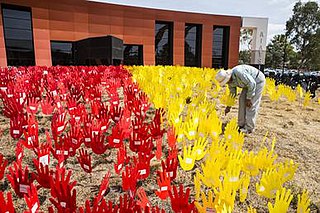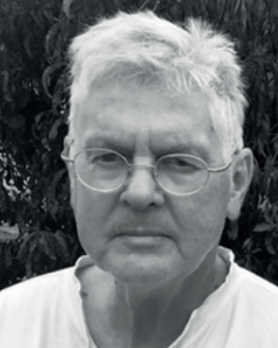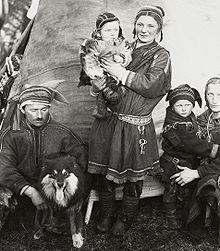
Anthropology is the scientific study of humanity, concerned with human behavior, human biology, cultures, societies, and linguistics, in both the present and past, including past human species. Social anthropology studies patterns of behavior, while cultural anthropology studies cultural meaning, including norms and values. A portmanteau term sociocultural anthropology is commonly used today. Linguistic anthropology studies how language influences social life. Biological or physical anthropology studies the biological development of humans.

Cultural anthropology is a branch of anthropology focused on the study of cultural variation among humans. It is in contrast to social anthropology, which perceives cultural variation as a subset of a posited anthropological constant. The term sociocultural anthropology includes both cultural and social anthropology traditions.

Ethnography is a branch of anthropology and the systematic study of individual cultures. Ethnography explores cultural phenomena from the point of view of the subject of the study. Ethnography is also a type of social research that involves examining the behavior of the participants in a given social situation and understanding the group members' own interpretation of such behavior.
The Central Australian Aboriginal Media Association (CAAMA) is an organisation founded in 1980 to expose Aboriginal music and culture to the rest of Australia. It started with 8KIN-FM, the first Aboriginal radio station in the country. Based in Alice Springs, the organisation is particularly focused on the involvement of the local Indigenous community in its production. CAAMA is involved in radio, television and recorded music.

Visual anthropology is a subfield of social anthropology that is concerned, in part, with the study and production of ethnographic photography, film and, since the mid-1990s, new media. More recently it has been used by historians of science and visual culture. Although sometimes wrongly conflated with ethnographic film, visual anthropology encompasses much more, including the anthropological study of all visual representations such as dance and other kinds of performance, museums and archiving, all visual arts, and the production and reception of mass media. Histories and analyses of representations from many cultures are part of visual anthropology: research topics include sandpaintings, tattoos, sculptures and reliefs, cave paintings, scrimshaw, jewelry, hieroglyphics, paintings and photographs. Also within the province of the subfield are studies of human vision, properties of media, the relationship of visual form and function, and applied, collaborative uses of visual representations.

Salvage ethnography is the recording of the practices and folklore of cultures threatened with extinction, including as a result of modernization and assimilation. It is generally associated with the American anthropologist Franz Boas; he and his students aimed to record vanishing Native American cultures. Since the 1960s, anthropologists have used the term as part of a critique of 19th-century ethnography and early modern anthropology.

The Australian Institute of Aboriginal and Torres Strait Islander Studies (AIATSIS), established as the Australian Institute of Aboriginal Studies (AIAS) in 1964, is an independent Australian Government statutory authority. It is a collecting, publishing, and research institute and is considered to be Australia's premier resource for information about the cultures and societies of Aboriginal and Torres Strait Islander peoples.
Digital anthropology is the anthropological study of the relationship between humans and digital-era technology. The field is new, and thus has a variety of names with a variety of emphases. These include techno-anthropology, digital ethnography, cyberanthropology, and virtual anthropology.

Sol Worth was a painter, photography and visual communication scholar.
John Adair, was an American anthropologist best known for work in visual anthropology but also very much involved and interested in applied anthropology.

Anthropology of media is an area of study within social or cultural anthropology that emphasizes ethnographic studies as a means of understanding producers, audiences, and other cultural and social aspects of mass media.

Peter Sutton FASSA is an Australian social anthropologist and linguist who has, since 1969, contributed to: recording Australian Aboriginal languages; promoting Australian Aboriginal art; mapping Australian Aboriginal cultural landscapes; and increasing societies' general understanding of contemporary Australian Aboriginal social structures and systems of land tenure.
Lester Richard Hiatt, known as Les Hiatt, was a scholar of Australian Aboriginal societies who promoted Australian Aboriginal studies within both the academic world and within the wider public for almost 50 years. He is now regarded as one of Australia's foremost anthropologists.

An ethnographic film is a non-fiction film, often similar to a documentary film, historically shot by Western filmmakers and dealing with non-Western people, and sometimes associated with anthropology. Definitions of the term are not definitive. Some academics claim it is more documentary, less anthropology, while others think it rests somewhere between the fields of anthropology and documentary films.
Faye Ginsburg is an American anthropologist who has devoted her life to the exploration of different cultures and individuals’ styles of life. Ginsburg has published ethnographies about her fieldwork experiences in the U.S., Canada and Australia. The intercultural connections in her ethnographies have contributed to the fields of anthropology and sociology because they allow readers to understand other cultures through her narratives. Currently, she is an anthropology professor at New York University and the director of the Center for Media, Culture and History at NYU.

Ethnocinema, from Jean Rouch’s cine-ethnography and ethno-fictions, is an emerging practice of intercultural filmmaking being defined and extended by Melbourne, Australia-based writer and arts educator, Anne Harris, and others. Originally derived from the discipline of anthropology, ethnocinema is one form of ethnographic filmmaking that prioritises mutuality, collaboration and social change. The practice's ethos claims that the role of anthropologists, and other cultural, media and educational researchers, must adapt to changing communities, transnational identities and new notions of representation for the 21st century.
Anthropology is the study of various aspects of humans within past and present societies. This study is practiced in multiple countries, each of whom has their own history of how anthropology has developed in their respective countries.

Disappearing World is a British documentary television series produced by Granada Television, which produced 49 episodes between 1970 and 1993. The episodes, each an hour long, focus on a specific human community around the world, usually but not always a traditional tribal group.
Teresa Montoya is a Diné media maker and social scientist with training in socio-cultural anthropology, critical Indigenous studies, and filmmaking.

David MacDougall is an American-Australian visual anthropologist, academic, and documentary filmmaker, who is known for his ethnographic film work in Africa, Australia, Europe and India. For much of his career he co-produced and co-directed films with his wife, fellow filmmaker Judith MacDougall. In 1972, his first film, To Live with Herds was awarded the Grand Prix "Venezia Genti" at the Venice Film Festival. He has lived in Australia since 1975, and is currently a professor in the Research School of Humanities & the Arts at Australian National University.








